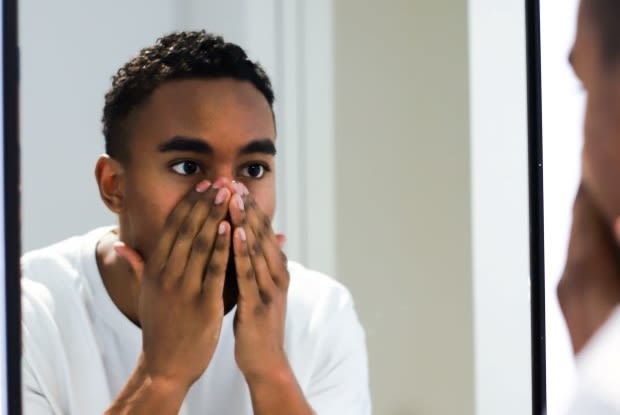Table of Contents
Understanding Acne
Seeing any type of spot or discoloration on your face can be upsetting, but most blemishes are benign and fairly easy to treat. Some blemishes may indicate a serious underlying health problem. More often than not, acne is affecting your skin. Acne is one of the most common skin conditions and affects people of all ages and genders. Acne usually shows up as pimples, blackheads, or whiteheads, which can be caused by bacteria, excess oil production, or clogged hair follicles. [1]
If you are experiencing acne, you can ask your doctor about Retin-A-Gel. Sometimes, acne can leave scars, and your doctor may also offer ways to get rid of acne scars. Acne medications like Azelex cream are typically topical creams or gels that are applied directly to the affected areas. Read on to learn more about acne and how it is diagnosed.
Why Does Acne Occur?
Acne is caused by one or more of the following factors:
- Inflammation
- Bacteria
- Clogged hair follicles
- Excess oil production
These factors are often interlinked. Excess oil (sebum) can clog the hair follicles, which can make it easier to trap dirt or dead skin cells. When these foreign substances irritate the hair follicles, inflammation can occur and increase the risk of bacterial infections. [2] So what causes these factors to occur?
Hormonal changes can cause excess sebum production. Boys and girls going through puberty may experience hormonal changes, which is why it is common to find teenagers struggling with acne. Women who are going through menopause may also experience spikes in androgens. Androgens are hormones that cause sebaceous glands to enlarge, which can lead to more frequent acne breakouts. [2] If you eat lots of carbohydrate-rich foods as part of your diet, you can be more susceptible to acne breakouts as well. Like hormonal changes, high levels of sugar from refined carbohydrates can cause dead skin cells to shed abnormally, combined with excess sebum to block your skin pores. [3] Medications you take may also increase your chance of acne. Several hormone-based medications are known to aggravate acne and worsen your symptoms, including: In addition to hormonal medications, several other types can worsen acne symptoms as well, including: There are a variety of acne subtypes that can affect you, such as: These subtypes are useful for identifying the cause and finding a successful treatment plan. Acne subtypes fall into two main categories: inflammatory and non-inflammatory. [5] Papules, pustules, nodules, and cysts are inflammatory acne subtypes. These types are generally caused by bacterial infections underneath the skin’s surface. As a result, inflammatory acne may cause swelling and skin redness. Papules are hard, clogged pores that become tender to the touch. They occur when the walls around your pores are severely inflamed and damaged. If you have papules, you may notice the skin surrounding your affected pores turning pink. Pustules are similar to papules except that they are filled with pus. Pustules also occur due to the breakdown of the walls around your pores. Because of the pus, pustules appear yellowish or white on top of a red bump. If your swollen pores are irritated further, they may grow larger and grow deeper into the skin. If this occurs, you may have nodules. Inflammatory nodules are too deep for most topical home treatments and may require prescription medication to clear up. Nodules that are left untreated can develop into cysts. Cysts affect even deeper parts of the skin than nodules. Cysts are the largest type of acne and often occur due to severe infections. Acne scars are most likely to occur from cysts than any other type of acne. [5] Non-inflammatory acne subtypes include blackheads and whiteheads. Non-inflammatory acne does not typically cause swelling and is easier to treat with over-the-counter treatments. Blackheads, also known as open comedones, result from sebum and dead skin cells buildup. Despite most of the pore being clogged, the top of a blackhead is open. This allows oxidation, which explains the black color. Whiteheads (open comedones) form much the same way as blackheads. The only difference is that the top of the pore remains closed. This can cause whiteheads to be slightly more difficult to treat, but a dermatologist will still be able to offer you several treatment options. Non-inflammatory acne isn’t as severe as inflammatory types and can generally be effectively treated with Retin-A-Gel. Even though whiteheads and blackheads aren’t considered severe, picking and popping them can still increase the risk of a bacterial infection and subsequent nodule or cyst. To avoid scarring, refrain from popping pimples and use topical treatment methods instead. [5] Your doctor will physically examine your face, chest, or any other affected areas to diagnose acne. To gauge the seriousness of your condition, your doctor will note the different subtypes present as well as their location and severity. If you predominantly have whiteheads and blackheads, you will likely be diagnosed with mild acne, even if a few pustules and papules are present. If you have widespread blackheads, whiteheads, papules, or pustules, you may have moderate acne. Severe acne is diagnosed if you are experiencing large and painful nodules or cysts. In women, excessive body hair growth (hirsutism) may accompany acne and indicate a hormonal imbalance in the body. This could be a sign of polycystic ovary syndrome (PCOS), which is more likely if you also have irregular or light periods. [6] By seeking treatment early, you can prevent your acne from worsening and leaving scars. By talking to a dermatologist, you can better understand this skin condition and get prescription-strength medications to control your acne. A dermatologist can also help you prevent additional scarring and make current scars less noticeable. Acne medications like Retin-A gel or cream reduce swelling and inflammation by treating bacterial infections under the skin. Acne medications generally consist of retinoids, antibiotics, and azelaic acid. Your doctor will determine which type of treatment is best for the severity of your acne. Most acne treatments take four to eight weeks to display significant results, and it can take long-term treatment to completely clear your acne. Some treatment regimens require a high level of commitment as they may involve washing and applying medications several times a day. On its own, acne isn’t particularly harmful, but it is important to ensure it does not indicate a more serious health problem. Talk to your doctor about your acne today. If you have already been prescribed acne medication, visit Canada Med Pharmacy to fill your acne prescription at discount prices today. The content in this article is intended for informational purposes only. This website does not provide medical advice. In all circumstances, you should always seek the advice of your physician and/or other qualified health professionals(s) for drug, medical condition, or treatment advice. The content provided on this website is not a substitute for professional medical advice, diagnosis, or treatment.
Types of Acne

a. Inflammatory
b. Non-Inflammatory

Diagnosis
Medications
